Related Research Articles
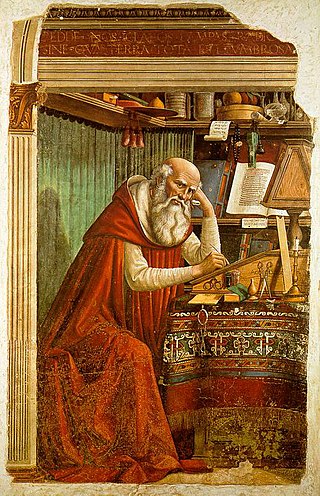
The Liber Pontificalis is a book of biographies of popes from Saint Peter until the 15th century. The original publication of the Liber Pontificalis stopped with Pope Adrian II (867–872) or Pope Stephen V (885–891), but it was later supplemented in a different style until Pope Eugene IV (1431–1447) and then Pope Pius II (1458–1464). Although quoted virtually uncritically from the 8th to 18th centuries, the Liber Pontificalis has undergone intense modern scholarly scrutiny. The work of the French priest Louis Duchesne, and of others has highlighted some of the underlying redactional motivations of different sections, though such interests are so disparate and varied as to render improbable one popularizer's claim that it is an "unofficial instrument of pontifical propaganda."
Pope Boniface II was the first Germanic bishop of Rome. He ruled the Holy See from 22 September 530 until his death on 17 October 532.
Pope Boniface V was the bishop of Rome from 23 December 619 to his death. He did much for the Christianisation of Anglo-Saxon England, and enacted the decree by which churches became places of sanctuary.
Pope Silverius was bishop of Rome from 8 June 536 to his deposition in 537, a few months before his death. His rapid rise to prominence from a deacon to the papacy coincided with the efforts of Ostrogothic king Theodahad, who intended to install a pro-Gothic candidate just before the Gothic War. Later deposed by Byzantine general Belisarius, he was tried and sent to exile on the desolated island of Palmarola, where he starved to death in 537.
Year 506 (DVI) was a common year starting on Sunday of the Julian calendar. At the time, it was known as the Year of the Consulship of Messala and Dagalaiphus. The denomination 506 for this year has been used since the early medieval period, when the Anno Domini calendar era became the prevalent method in Europe for naming years.
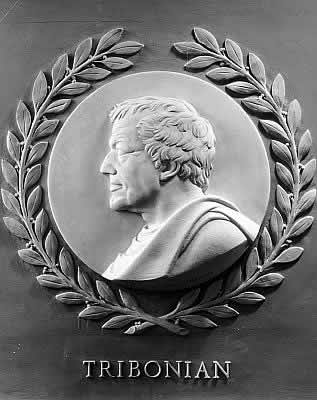
Year 530 (DXXX) was a common year starting on Tuesday of the Julian calendar. In the Roman Empire, it was known as the Year of the Consulship of Lampadius and Probus. The denomination 530 for this year has been used since the early medieval period, when the Anno Domini calendar era became the prevalent method in Europe for naming years.
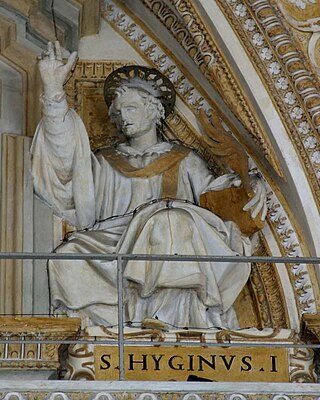
Pope Hyginus was the bishop of Rome from c. 138 to his death in c. 142. Tradition holds that during his papacy he determined the various prerogatives of the clergy and defined the grades of the ecclesiastical hierarchy.
Pope Gelasius I was the bishop of Rome from 1 March 492 to his death on 19 November 496. Gelasius was a prolific author whose style placed him on the cusp between Late Antiquity and the Early Middle Ages. Some scholars have argued that his predecessor Felix III may have employed him to draft papal documents, although this is not certain.

Pope Symmachus was the bishop of Rome from 22 November 498 to his death. His tenure was marked by a serious schism over who was elected pope by a majority of the Roman clergy.
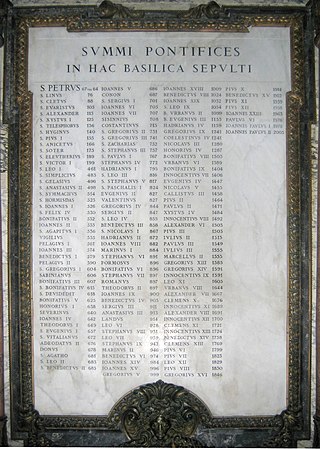
Pope Hormisdas was the bishop of Rome from 20 July 514 to his death. His papacy was dominated by the Acacian schism, started in 484 by Acacius of Constantinople's efforts to placate the Monophysites. His efforts to resolve this schism were successful, and on 28 March 519, the reunion between Constantinople and Rome was ratified in the cathedral of Constantinople before a large crowd.

Pope Felix IV was the bishop of Rome from 12 July 526 to his death. He was the chosen candidate of Ostrogoth King Theodoric the Great, who had imprisoned Felix's predecessor, John I.
Pope Sisinnius was the bishop of Rome from 15 January 708 to his death on 4 February. Besides being Syrian and his father being named John, little is known of Sisinnius' early life or career. At the time of his election to the papal throne, Sisinnius suffered from severe gout, leaving him weak. During the course of his twenty-day papacy, Sisinnius consecrated a bishop for Corsica and ordered the reinforcement of the walls surrounding the papal capital of Rome. On his death, Sisinnius was buried in Old St. Peter's Basilica. He was succeeded by Pope Constantine.
Laurentius was the Archpriest of Santa Prassede and later antipope of the See of Rome. Elected in 498 at the Basilica Saint Mariae with the support of a dissenting faction with Byzantine sympathies, who were supported by Eastern Roman Emperor Anastasius I Dicorus, in opposition to Pope Symmachus, the division between the two opposing factions split not only the church, but the Senate and the people of Rome. However, Laurentius remained in Rome as pope until 506.
Theodore was a rival with Paschal for the papacy following the death of Pope Conon, and thus is considered an antipope of the Roman Catholic Church.
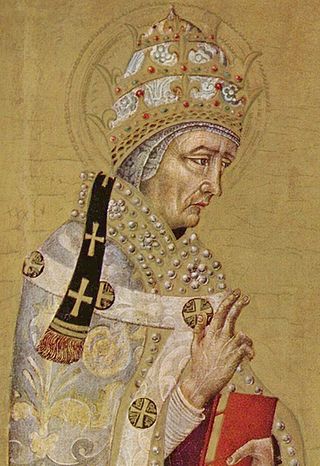
The selection of the Pope, the Bishop of Rome and Supreme Pontiff of the Catholic Church, prior to the promulgation of In Nomine Domini in AD 1059 varied throughout history. Popes were often putatively appointed by their predecessors or by political rulers. While some kind of election often characterized the procedure, an election that included meaningful participation of the laity was rare, especially as the Popes' claims to temporal power solidified into the Papal States. The practice of papal appointment during this period would later result in the putative jus exclusivae, i.e., the claimed but invalid right to veto the selection that Catholic monarchs exercised into the twentieth century.
The numbering of "Popes John" does not occur in strict numerical order. Although there have been twenty-one legitimate popes named John, the numbering has reached XXIII because of two clerical errors that were introduced in the Middle Ages: first, antipope John XVI was kept in the numbering sequence instead of being removed; then, the number XX was skipped because Pope John XXI counted John XIV twice.

The Ostrogothic Papacy was a period from 493 to 537 where the papacy was strongly influenced by the Ostrogothic Kingdom, if the pope was not outright appointed by the Ostrogothic King. The selection and administration of popes during this period was strongly influenced by Theodoric the Great and his successors Athalaric and Theodahad. This period terminated with Justinian I's (re)conquest of Rome during the Gothic War (535–554), inaugurating the Byzantine Papacy (537–752).
Rufius Petronius Nicomachus Cethegus was a politician of Ostrogothic Italy and the Eastern Roman Empire. He was appointed consul for 504 AD, and held the post without a colleague. His father was Petronius Probinus, the consul for 489 and prominent supporter of Antipope Laurentius.
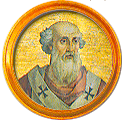
The Lateran Council of 769 was a synod held in the Basilica of St. John Lateran to rectify perceived abuses in the papal electoral process which had led to the elevation of the antipopes Constantine II and Philip. It also condemned the rulings of the Council of Hieria. It is perhaps the most important Roman council held during the 8th century.
References
- ↑ Richards 1979, p. 76.
- ↑ Richards 1979, pp. 107f, 123.
- ↑ Haendler 2006.
- ↑ Richards 1979, p. 122.
- ↑ Richards 1979, p. 123.
- ↑ Richards 1979, p. 124.
- 1 2 Oestereich 1909.
- ↑ Davis 1989, pp. 50–51.
Sources
![]() This article incorporates text from a publication now in the public domain : Oestereich, Thomas (1909). "Dioscorus". In Herbermann, Charles (ed.). Catholic Encyclopedia . Vol. 5. New York: Robert Appleton Company.
This article incorporates text from a publication now in the public domain : Oestereich, Thomas (1909). "Dioscorus". In Herbermann, Charles (ed.). Catholic Encyclopedia . Vol. 5. New York: Robert Appleton Company.
- Davis, Raymond (1989). The Book of Pontiffs (Liber Pontificalis) : the ancient biographies of the first ninety Roman Bishops to AD715. Liverpool: Liverpool University Press. doi:10.3828/978-1-84631-476-6. ISBN 9780853232162. OCLC 1148009183.
- Haendler, Gert (2006). "Dioscorus, Antipope". In Betz, Hans (ed.). Religion Past and Present : encyclopedia of theology and religion. Leiden Boston: Brill. doi:10.1163/1877-5888_rpp_SIM_03739. ISBN 9789004146662. ISSN 1877-5888. OCLC 62290620.
- Richards, Jeffrey (1979). The popes and the papacy in the early Middle Ages, 476-752 . London Boston: Routledge & Kegan Paul. ISBN 9780710000989. OCLC 1011528215.